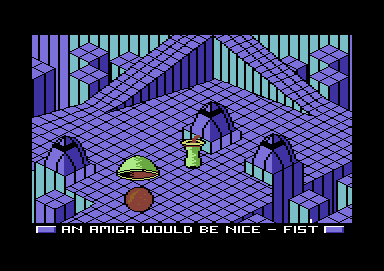
The project was canceled and the two began working on an idea of Cerny's that eventually became Marble Madness. Ĭerny and Flanagan first collaborated on a video game based on Michael Jackson's Thriller. The game's music was composed by Brad Fuller and Hal Canon who spent a few months becoming familiar with the sound chip's capabilities. Marble Madness was the very first arcade game to use an FM sound chip produced by Yamaha, similar to a Yamaha DX7 synthesizer, which created the music in real time so that it was in synchronization with the game's on-screen action. The game features pixel graphics on a 19-inch Electrohome G07 model CRT monitor and uses a Motorola 68010 central processing unit (CPU) with a MOS Technology 6502 subsystem to control the audio and coin operations. It uses the Atari System 1 hardware, which was an interchangeable system of circuit boards, control panels, and artwork. Both Cerny and Flanagan handled programming the game.
#C64 marble madness music software
Marble Madness was developed by Atari Games, with Mark Cerny as the lead designer and Bob Flanagan as the software engineer. For example, the first race (titled "Practice") is a simple course that is much shorter than the others, while the fifth race (named "Silly") features polka-dot patterns and is oriented in a direction opposite that of the other courses. As the game progresses, the courses become increasingly difficult and introduce more enemies and obstacles. Ĭourses are populated with various objects and enemies designed to obstruct the player. The game allows two players to compete against each other, awarding bonus points and extra time to the winner of each race both players have separate clocks. With the exception of the first race, any time left on the clock at the end of a race is carried over to the next one, and the player is granted a set amount of additional time as well. The player's goal is to complete six maze-like isometric race courses before a set amount of time expires. In the arcade version, a player controls the marble's movements with a trackball most home versions use game controllers with directional pads. Marble Madness is an isometric platform game in which the player manipulates an onscreen marble from a third-person perspective. Scores and available time are tracked at the top of the screen.

The blue, player-controlled marble traverses an isometric course. A sequel was developed and planned for release in 1991, but canceled when location testing showed the game could not succeed in competition with other titles.

The game was ported to numerous platforms and inspired the development of other games. Critics praised the game's difficulty, unique visual design, and stereo soundtrack. Upon its release to arcades, Marble Madness was commercially successful and profitable. Throughout development, he was frequently impeded by limitations in technology and had to forgo several design ideas. Cerny applied a minimalist approach in designing the appearance of the game's courses and enemies. He aimed to create a game that offered a distinct experience with a unique control system. In designing the game, Cerny drew inspiration from miniature golf, racing games, and artwork by M. Marble Madness is known for using innovative game technologies: it was Atari's first to use the Atari System 1 hardware, the first to be programmed in the C programming language, and one of the first to use true stereo sound (previous games used either monaural sound or simulated stereo). The player controls the marble by using a trackball.

It is a platform game in which the player must guide a marble through six courses, populated with obstacles and enemies, within a time limit. Marble Madness is an arcade video game designed by Mark Cerny and published by Atari Games in 1984.


 0 kommentar(er)
0 kommentar(er)
